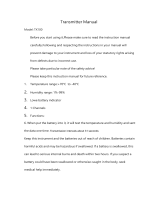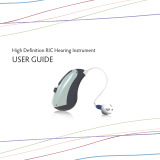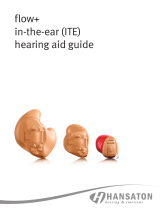Page is loading ...

resound.com
User guide
Custom hearing aids
400332011-US-16.11-Rev.F.indd 1 15-12-2016 12:32:13

2
Hearing instrument type designations for models included in this user guide are: DA312r, FCC ID:
X26DA312r, IC: 6941C-DA312r; DA13r, FCC ID: X26DA13r, IC: 6941C-DA13r; DA312i, FCC ID: X26DA312i,
IC: 6941C-DA312i; and DA13i, FCC ID: X26DA13i, IC: 6941C-DA13i. Please see page 8, 10 and 12 for lists
of models referring to these types.
Statement:
This device complies with part 15 of the FCC rules and ICES-003 of the IC rules.
Operation is subject to the following two conditions: (1) this device may not cause harmful inter ference,
and (2) this device must accept any interference received, including interference that may cause undesired
operation.
Note: This equipment has been tested and found to comply with the limits for a Class B digital device, pur-
suant to part 15 of the FCC Rules and ICES-003 of the IC rules. These limits are designed to provide rea-
sonable protection against harmful interference in a residential installation. This equipment generates, uses
and can radiate radio frequency energy and, if not installed and used in accordance with the instructions,
may cause harmful interference to radio communications. However, there is no guarantee that interference
will not occur in a particular installation. If this equipment does cause harmful interference to radio or televi-
sion reception, which can be determined by turning the equipment off and on, the user is encouraged to try
to correct the interference by one or more of the following measures:
• Reorient or relocate the receiving antenna.
• Increase the separation between the equipment and receiver.
• Connect the equipment into an outlet on a circuit different from the one in which the receiver is con-
nected.
• Consult the dealer or an experienced radio/TV technician for help.
Changes or modifications can void the user´s authority to operate the equipment.
400332011-US-16.11-Rev.F.indd 2 15-12-2016 12:32:15

3
Intended use
Generic air-conduction hearing instruments are wearable sound-amplifying devices intended to compen-
sate for impaired hearing. The fundamental operating principle of hearing instruments is to receive, amplify,
and transfer sound to the ear drum of a hearing impaired person.
The products are in compliance with the following regulatory requirements:
• In US: FCC CFR 47 Part 15, subpart C.
• Other identified applicable international regulatory requirements in countries outside the US. Please refer
to local country requirements for these areas.
• In Canada: these hearing instruments are certified under the rules of IC.
• Japanese Radio Law and Japanese Telecommunications Business Law Compliance. This device is
granted pursuant to the Japanese Radio Law (電波法) and the Japanese telecommunications Business
Law (電気通信事業法) This device should not be modified (otherwise the granted designation number
will become invalid).
• Patents:
US 7,593,537 US 8,00,849
400332011-US-16.11-Rev.F.indd 3 15-12-2016 12:32:15

4
Introduction
Congratulations on the purchase of your new hearing instruments. ReSound’s innovative sound technology
and design, combined with the customized device programming selected by your hearing care profes-
sional, will make hearing a more enjoyable experience. Hearing instruments will enable you to hear sounds
that you may not have heard in years because of your hearing loss. Practice and a positive attitude are
important in learning to use hearing instruments. Your ReSound instruments have been adjusted according
to your individual hearing loss and needs. Some people adjust quickly to wearing hearing instruments in
their ears and hearing new sounds; other people may need more time.
This product is a custom-made device.
Please read this manual carefully in order to wholly benefit from the use of your hearing instruments. With
proper care, maintenance, and usage, your hearing instruments will aid you in better communication for
many years. Ask your hearing care professional if you have any questions.
ReSound is a registred trade mark of ReSound A/S
400332011-US-16.11-Rev.F.indd 4 15-12-2016 12:32:18

5
Hearing instrument model:
Model CIC: Battery size 10
Model IIC: Battery size 10
Model ITC: Battery size 13 or 312 (circle one)
Model ITE: Battery size 13 or 312 (circle one)
Model MIH: Battery size 13, 312, or 10 for MIH-S (circle one)
Left serial number:
Right serial number:
Smart Start ......................14
Volume control ...................20
Program button...................21
Wireless .....................22, 25
Phone Now ......................26
Tinnitus Sound Generator...........34
Telecoil/Tele-loop system ........23, 28
Power device-exceeds 132 dB SPL .....
Specific features supported by your hearing system:
Ask your hearing care professional to mark the options supported by your hearing system.
400332011-US-16.11-Rev.F.indd 5 15-12-2016 12:32:18

6
Contents
Statement: ............................2
Intended use ..........................3
Introduction............................4
Specific features supported by your
hearing system:.........................5
Contents ..............................6
Getting started ........................14
SmartStart ...........................14
Inserting/Replacing the battery............15
Low battery indicator ...................16
Low battery indicator when paired with
wireless accessories only ................16
Inserting/Removing hearing instruments.....17
Operation of the hearing instrument . . . . . . . . 20
Flight mode* ..........................22
Telephone use.........................23
Telecoil (optional on some ITC, ITE,
and Mic in Helix models) .................23
Listening to radio or TV ..................24
Using ReSound hearing instruments with
smart phone apps......................24
Use with smart phone apps:..............24
Using ReSound Hearing Instruments with
iPhone
®
, iPad
®
, and iPod touch
®
...........25
Cellular phones........................25
PhoneNow (not available in IIC instruments) ..26
Tele-loop systems......................28
Care and maintenance ..................28
Daily maintenance......................29
Replacing wax filters ....................30
General precautions ....................31
General warnings ......................32
Tinnitus Sound Generator (TSG) module ....34
Intended use for the TSG module ..........34
Prescription use of this TSG hearing
instrument............................34
Important notice for prospective sound
generator users........................35
400332011-US-16.11-Rev.F.indd 6 15-12-2016 12:32:19

7
User instructions for the TSG module .......35
Using TSG with smart phone apps .........37
The scientific concepts that form the basis
for the device .........................37
Technical Specifications .................38
TSG warnings .........................38
TSG precautions.......................39
TSG warning to hearing healthcare
professionals..........................39
Battery warning information ..............41
Hearing instrument expectations ..........41
Warning to hearing aid dispensers
(US Only).............................42
Important notice for prospective hearing
aid users (US Only) . . . . . . . . . . . . . . . . . . . . . 42
Children with hearing loss (US Only) ........43
Troubleshooting Guide ..................44
Technical Data ........................48
Warranty and repairs ...................49
Temperature test, transport and storage
information ...........................49
400332011-US-16.11-Rev.F.indd 7 15-12-2016 12:32:30

8
Mic in Helix (MIH-S) hearing instrument models
with size 10A battery are available in the following
variants:
LS9MIH-S UP, LS9MIH-S HP, LS9MIH-S MP,
LS9MIH-S LP, LS7MIH-S UP, LS7MIH-S HP,
LS7MIH-S MP, LS7MIH-S LP, LS5MIH-S UP,
LS5MIH-S HP, LS5MIH-S MP, LS5MIH-S LP
Mic in Helix (MIH) hearing instruments
(including type DA312r with FCC ID X26DA312r,
IC number 6941C-DA312r models designated by
a “W”) with size 312 battery and Custom Mic in
Helix hearing instruments (including type DA13r
with FCC ID X26DA13r, IC number 6941C-DA13r
models designated by a “W”) with size 13 battery
are available in the following variants:
LS9MIH-W UP, LS9MIH-W HP, LS9MIH-W MP,
LS9MIH-W LP, LS9MIH UP, LS9MIH HP,
LS9MIH MP, LS9MIH LP, LS7MIH-W UP,
LS7MIH-W HP, LS7MIH-W MP, LS7MIH-W LP,
LS7MIH UP, LS7MIH HP, LS7MIH MP, LS7MIH
LP
LS5MIH-W UP, LS5MIH-W HP, LS5MIH-W MP,
LS5MIH-W LP, LS5MIH UP, LS5MIH HP,
LS5MIH MP, LS5MIH LP
400332011-US-16.11-Rev.F.indd 8 15-12-2016 12:32:34

9
1. Program button (optional)
2. Battery compartment and On/Off switch
3. Removal cord (optional)
4. Sound outlet
5. Wax filter
6. Vent
7. Microphone sound inlet
8. Remote microphone and tubing
(for remote microphone devices)
9. Volume control (optional)
10. Model
11. Manufacturer
12. Serial number
8
6
7
4
5
2
2
4
9
1
3
8
11
12
10
3
8
6
GN ReSound
ReSound LiNX
2
XXXXXXX
400332011-US-16.11-Rev.F.indd 9 15-12-2016 12:32:43

10
Invisible-in-the-canal (IIC) and
completely-in-the-canal (CIC) hearing
instruments with size 10A battery are available in
the following variants:
LS9IIC, LS7IIC, LS5IIC, LS9CIC UP, LS9CIC HP,
LS9CIC MP, LS9CIC LP, LS7CIC UP,
LS7CIC HP, LS7CIC MP, LS7CIC LP,
LS5CIC UP, LS5CIC HP, LS5CIC MP,
LS5CIC LP, EY3CIC UP, EY3CIC HP, EY3CIC
MP, EY3CIC LP, EY2CIC UP, EY2CIC HP,
EY2CIC MP, EY2CIC LP.
In-the-canal (ITC) hearing instruments (including
type DA312i with FCC ID X26DA312i, IC number
6941C-DA312i models designated by a “W”)
with size 312 battery and In-the-canal (ITC)
hearing instruments (including type DA13i with
FCC ID X26DA13i, IC number 6941C-DA13i models
designated by a “W”) with size 13 battery are
available in the following variants:
LS9ITC-DW UP, LS9ITC-DW HP,
LS9ITC-DW MP, LS9ITC-DW LP,
LS9ITC-DWE MP, LS9ITC-D UP, LS9ITC-D HP,
LS9ITC-D MP, LS9ITC-D LP, LS9ITC-W UP,
LS9ITC-W HP, LS9ITC-W MP, LS9ITC-W LP,
LS9ITC UP, LS9ITC HP, LS9ITC MP, LS9ITC LP,
LS7ITC-DW UP, LS7ITC-DW HP, LS7ITC-DW MP,
LS7ITC-DW LP, LS7ITC-D UP, LS7ITC-D HP,
LS7ITC-D MP, LS7ITC-D LP, LS7ITC-W UP,
LS7ITC-W HP, LS7ITC-W MP, LS7ITC-W LP,
LS7ITC UP, LS7ITC HP, LS7ITC MP, LS7ITC LP,
LS5ITC-DW UP, LS5ITC-DW HP, LS5ITC-DW MP,
LS5ITC-DW LP, LS5ITC-D UP, LS5ITC-D HP,
LS5ITC-D MP, LS5ITC-D LP, LS5ITC-W UP,
LS5ITC-W HP, LS5ITC-W MP, LS5ITC-W LP,
LS5ITC UP, LS5ITC HP, LS5ITC MP, LS5ITC LP
EY3ITC-DW UP, EY3ITC-DW HP, EY3ITC-DW MP,
EY3ITC-DW LP, EY3ITC-D UP, EY3ITC-D HP,
EY3ITC-D MP, EY3ITC-D LP, EY3ITC-W UP,
EY3ITC-W HP, EY3ITC-W MP, EY3ITC-W LP,
EY3ITC UP, EY3ITC HP, EY3ITC MP, EY3ITC LP,
EY2ITC-DW UP, EY2ITC-DW HP, EY2ITC-DW MP,
EY2ITC-DW LP, EY2ITC-D UP, EY2ITC-D HP,
EY2ITC-D MP, EY2ITC-D LP, EY2ITC-W UP,
EY2ITC-W HP, EY2ITC-W MP, EY2ITC-W LP,
EY2ITC UP, EY2ITC HP, EY2ITC MP, EY2ITC LP.
400332011-US-16.11-Rev.F.indd 10 15-12-2016 12:32:45

GN ReSound
ReSound LiNX
2
XXXXXXX
11
1. Program button (optional)
2. Battery compartment and On/Off switch
3. Removal cord (optional)
4. Sound outlet
5. Wax filter
6. Vent
7. Microphone sound inlet(s)
8. Volume control (optional)
9. Model
10. Manufacturer
11. Serial number
1
7
7
6
8
2
9
10
11
3
6
2
7
4
8
1
3
5
400332011-US-16.11-Rev.F.indd 11 15-12-2016 12:32:50

12
In-the-ear (ITE) hearing instruments (including
type DA13i with FCC ID X26DA13i, IC number
6941C-DA13i models designated by a “W”) with
size 13 battery and In-the-ear (ITE) hearing
instruments (including type DA312i with FCC ID
X26DA312i, IC number 6941C-DA312i models
designated by a “W”) with size 312 battery are
available in the following variants:
LS9ITE-DW UP, LS9ITE-DW HP,
LS9ITE-DW MP, LS9ITE-D UP, LS9ITE-D HP,
LS9ITE-D MP, LS9ITE-W UP, LS9ITE-W HP,
LS9ITE-W MP, LS9ITE UP, LS9ITE HP,
LS9ITE MP, LS7ITE-DW UP, LS7ITE-DW HP,
LS7ITE-DW MP, LS7ITE-D UP, LS7ITE-D HP,
LS7ITE-D MP, LS7ITE-W UP, LS7ITE-W HP,
LS7ITE-W MP, LS7ITE UP, LS7ITE HP,
LS7ITE MP, LS5ITE-DW UP, LS5ITE-DW HP,
LS5ITE-DW MP, LS5ITE-D UP, LS5ITE-D HP,
LS5ITE-D MP, LS5ITE-W UP, LS5ITE-W HP,
LS5ITE-W MP, LS5ITE UP, LS5ITE HP,
LS5ITE MP
EY3ITE-DW UP, EY3ITE-DW HP,
EY3ITE-DW MP, EY3ITE-D UP, EY3ITE-D HP,
EY3ITE-D MP, EY3ITE-W UP, EY3ITE-W HP,
EY3ITE-W MP, EY3ITE UP, EY3ITE HP,
EY3ITE MP,
EY2ITE-DW UP, EY2ITE-DW HP,
EY2ITE-DW MP, EY2ITE-D UP, EY2ITE-D HP,
EY2ITE-D MP, EY2ITE-W UP, EY2ITE-W HP,
EY2ITE-W MP, EY2ITE UP, EY2ITE HP,
E Y2 IT E M P.
400332011-US-16.11-Rev.F.indd 12 15-12-2016 12:32:52

13
1. Program button (optional)
2. Battery compartment and On/Off switch
3. Sound outlet
4. Wax filter
5. Vent
6. Microphone sound inlet(s)
7. Volume control (optional)
8. Model
9. Manufacturer
10. Serial number
6
2
3
7
1
6
5
4
GN ReSound
ReSound LiNX
2
XXXXXXX
10
9
8
5
4
400332011-US-16.11-Rev.F.indd 13 15-12-2016 12:32:55

14
Getting started
On/Off function
1. When the battery door is closed, the hearing instrument
will turn on, and the default program will be activated.
2. To turn the hearing instrument off, open the battery door.
Many individuals can use their fingernail to pull it open.
i
Tip: Whenever the hearing instruments are not in use,
remember to open the battery doors to avoid unnecessary battery consumption.
SmartStart
Hearing instruments can be turned on once you have placed them on your ears. If you prefer to turn them on
just prior to placing them in your ears, your hearing care professional can activate a function called Smart-
Start. This function will delay the time in which the hearing instruments turn on by several seconds after the
battery compartment is closed. With SmartStart, a beep will be heard for each second of the delay period.
On
Off
400332011-US-16.11-Rev.F.indd 14 15-12-2016 12:33:02

1 2 3
15
Inserting/Replacing the battery
1. Open the battery door completely by using your fingernail. Remove the used battery if present.
2. Prepare the new battery (please refer to page 5 for information on appropriate battery type/size for your
hearing instrument). Remove the protective foil and wait 2 minutes before inserting the battery into the
hearing instrument to allow activation of the battery.
3. Insert the new battery with the positive side in the correct position.
4. Gently close the battery door.
i
Tip:
1. Always use new Zinc-Air batteries that have a minimum remaining shelf life of 1 year.
2. Whenever the hearing instruments are not in use, remember to turn them
off to avoid unnecessary battery consumption.
400332011-US-16.11-Rev.F.indd 15 15-12-2016 12:33:10

16
Low battery indicator
Your hearing care professional can activate a low battery indicator in your hearing instruments. The hear-
ing instrument will reduce amplification and emit a beep signal if battery power gets too low. This signal
will recur every 15 minutes until the hearing instrument automatically switches off. The low battery indicator
can vary slightly, depending on the type of battery used. It is recommended that you keep spare batteries
on hand.
Low battery indicator when paired with wireless accessories only
Active usage of the ReSound Unite accessories (Remote Control 2, Phone Clip+, TV Streamer 2 and Mini
Microphone) requires more battery power from the hearing instruments than when these are working with-
out accessories which means that battery life is highly dependent on the amount of wireless accessory
usage. When the battery in the hearing instrument has depleted to a level at which use of the ReSound
Unite TV Streamer 2, Phone Clip+ and Mini Microphone cannot be supported, the hearing instrument will
play two sets of descending tones.
After this, your hearing instrument and ReSound Unite Remote Control 2 will continue to work as usual, but
you will not be able to use your ReSound Unite TV Streamer 2, Phone Clip+ and Mini Microphone. At some
point the battery level will also be too low to support the remote control as well and you will once again
hear the descending tones. The hearing instruments will continue to work as usual. Once a new battery is
inserted, full operation of the accessories will resume.
400332011-US-16.11-Rev.F.indd 16 15-12-2016 12:33:11

17
Inserting/Removing hearing instruments
Insertion (Mic in Helix)
1. Hold the hearing instrument between your thumb and index finger, either
above and below or on the sides.
2. Place the sound outlet portion into your ear canal. Turn the top part of
the hearing instrument gently backwards and forwards so that it tucks
behind the fold of skin above your ear canal.
3. Insert the hearing instrument into your ear canal. Opening and closing
your mouth may ease insertion.
4. Gently push the microphone into the creased area of the ear that is located
above the microphone entrance, and make sure the tubing is in place.
400332011-US-16.11-Rev.F.indd 17 15-12-2016 12:33:16

18
Insertion (IIC, CIC, ITC, and ITE)
1. Hold the hearing instrument between your thumb and index finger, either above
and below or on the sides. For IIC, there is a dot on the top side of the shell to show
orientation for insertion.
2. Place the sound outlet portion into your ear canal. Turn the top part of the hearing
instrument gently backwards and forwards so that it tucks behind the fold of skin
above your ear canal.
3. Insert the hearing instrument into your ear canal. Opening and closing your mouth
may ease insertion.
By experimenting, an easier method may be discovered. With proper insertion, hearing
instruments should fit snugly but comfortably. If the hearing instruments cause irritation
of the ears, contact your hearing care professional.
i Never attempt to modify the shape of the hearing instrument yourself.
i
Tip: It may be helpful to pull your ear up and outward with your opposite hand during insertion.
IIC
400332011-US-16.11-Rev.F.indd 18 15-12-2016 12:33:21

19
Removal options (IIC, CIC and Mic in Helix)
1. Hold the removal cord with your thumb and index finger and pull outward.
2. Hold the edges of the hearing instrument with your thumb and forefinger
and pull outward while slightly rotating your hand forward.
3. If Mic in Helix hearing instruments do not have a removal cord, gently pull
outward with the microphone tubing.
Removal (ITC and ITE)
1. Hold the edges of the hearing instrument with your thumb and forefinger.
2. Pull outward while slightly rotating your hand forward.
i Note: Consult your hearing care professional if you have difficulty remov-
ing the hearing instruments.
400332011-US-16.11-Rev.F.indd 19 15-12-2016 12:33:22

20
Operation of the hearing instrument
Volume control (Optional)
The volume control will allow the volume of hearing instruments to be increased or decreased.
1. To increase the volume, rotate the volume control forward (towards your face when you are wearing the
hearing instruments).
2. To decrease the volume, rotate the volume control backward (away from your face).
When volume is increased or decreased,
a beep signal will be heard for each incre-
mental change. When the upper or lower
limits of the volume range are reached, a
beep signal with a longer duration will be
heard.
400332011-US-16.11-Rev.F.indd 20 15-12-2016 12:33:25
/





